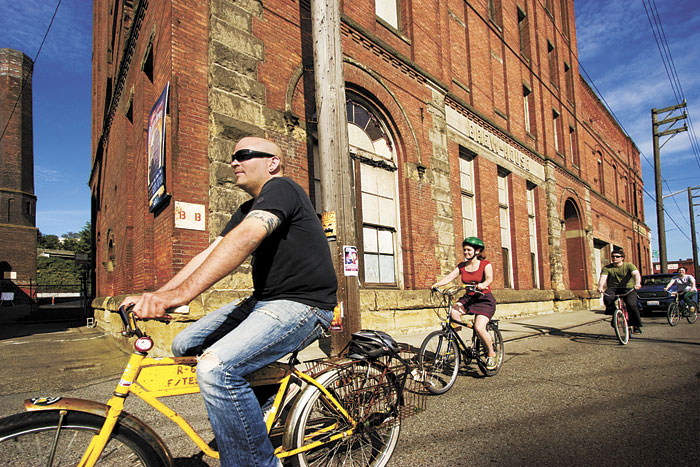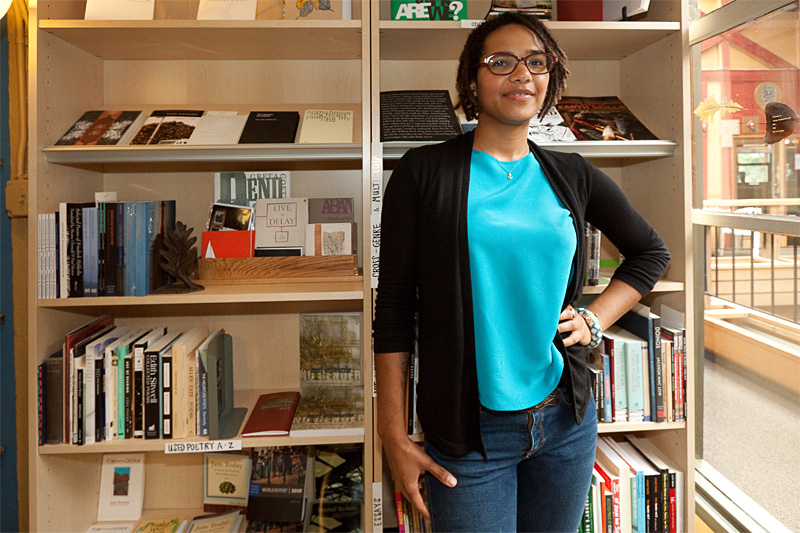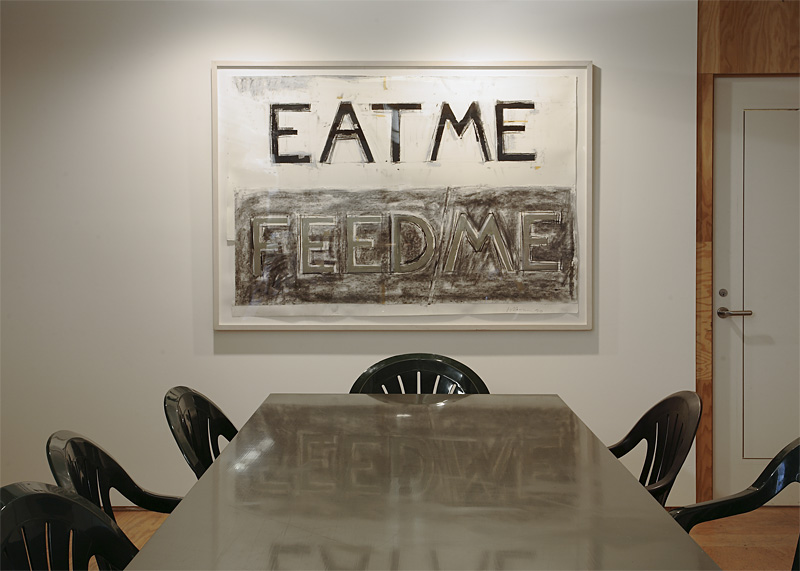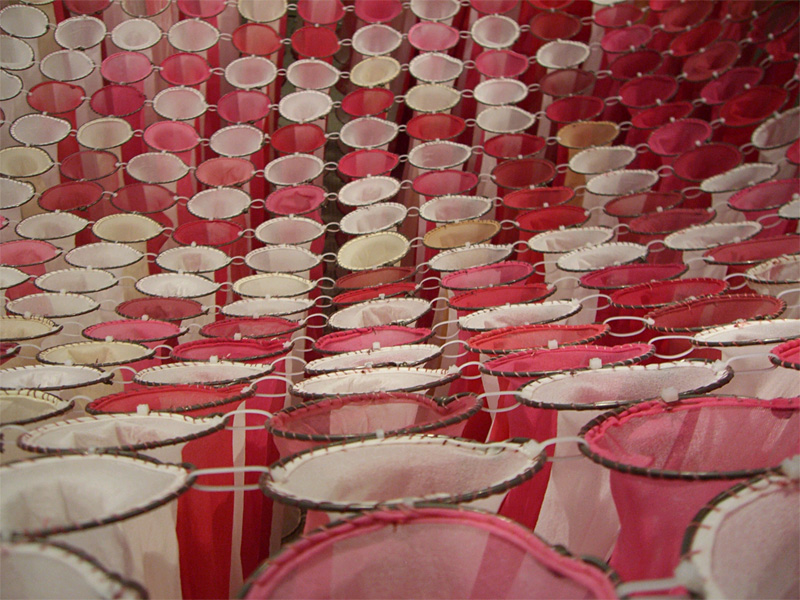I bike to get around, and living in SoDo means I share the road with 18-wheelers, stadium traffic, and people thinking they’ve found a quick backstreet substitute for I-5 along Airport Way South.
For the most part, my biking is practical. For three months straight last year, every time I took my car downtown, I’d head home with a parking ticket. Those meter readers on Segways (looking like they’re having far too much fun spreading gloom) seemed to see me coming. So I reverted to two wheels, bike racks, and my own power. Despite repeated soakings, I biked all winter.
Biking in the South End has its own special demands, however. I recently upgraded to tires enhanced with bulletproof fabric, fed up with the many slow leaks I’d get simply going to and from downtown. Between the heavy industry, the traffic, the detritus scattered by the South End’s large homeless population, and the city’s lack of interest in street-sweeping, SoDo roads are a mess of broken glass, potholes, and tiny metal bits.
Don’t even try to join the main thoroughfare, Airport Way South, at rush hour—those drivers like to honk as if you’re supposed to be on the sidewalk instead of in their lane. Elliott Avenue and First Avenue South are more scenic, but crowded with truckers understandably preoccupied with bringing their loads to port. Some days it’s worth the view of Elliott Bay—the sun, the mountains, all those container ships—but often the long, flat stretch to downtown is simply too rough, too exposed, and too out-of-scale. A bike is puny along this route, and despite whatever fancy flashing lights you’ve got going, you know you’re nearly invisible.
Sound Transit recently began cleaning up the bikeway along its light-rail tracks, creating a quieter route and a smoother pavement than any of the major arterials. The paved trail runs from South Royal Brougham Way down to the light-rail overpass at Sixth Avenue South and South Forest Street (right around the Franz Family Bakeries, which you can smell for miles). [This story has been corrected since it was first published. It originally said the trail started at “Dearborn Ave.”] Planted with trees and bushes, this way offers, for the most part, a more meditative, car-free path back and forth. Yet even with Sound Transit’s defensive landscaping—fenced-in shrubbery occupies what used to be homeless encampments—you’ve got to be ready to swerve to avoid swaying drunks or their telltale smashed forties.
As for local scenery, there’s the Hat and Boots, of course. Take Corson Avenue South past Oxbow Park and find them next to the Georgetown Pea Patch. Currently under renovation, the hat is completely wrapped in white plastic. Dating to a 1954 “Premium Tex” Texaco Station, this kitschy landmark was moved to the park in 2003. Originally designed as restrooms for the gas station, the 22-foot-tall cowboy boots have already been restored. They’re a mismatched set kids like to climb on: one pale blue, one black.
A few blocks away, past some colorful Victorian houses and shiny new townhomes, is a shop that wears its owner’s obsessions on a chain-link fence. Kevin Bradley displays his collection of found objects. Wooden toy airplanes and naked plastic dolls share space with signs advertising tool repair. Located at 6310 Ellis Ave. S., this is the New2You General Store. Some might consider it an eyesore, and some of the items show signs of vandalism, but this longstanding neighborhood oddity is a relic of Georgetown past. [Note: Since this story was published, it has come to our attention that Mr. Bradley is awaiting trial on charges of child molestation.]
Want to pack a lunch before you head to the Duwamish for a picnic along this most famous of Superfund sites? Stop into Maruta Grocery (1024 S. Bailey St.) for some Japanese food (their house-made sushi goes on sale at 5 p.m.) or head to the Carleton Avenue Grocery for bread and cheese. Smack dab in the middle of Georgetown, All City Coffee is the place for coffee, and if you’re early enough, pastries too. Stuff your panniers and head south along Corson until you get to East Marginal Way. Take the winding bike spiral up and over the First Avenue South Bridge, and once you’ve crossed, head north to the inspiringly named Port of Seattle Terminal 107 Park at 4700 West Marginal Way S.W. Adjacent to Terminal 107, this eight-acre park has been the site of much native-plant restoration work, and offers an idyllic waterfront spot for a picnic. Head north from here and you’ll come across massive glittering cubes of recycled scrap metal, rusty segments of railroad track, and stacks upon stacks of colorful shipping containers.
If you’re more in the mood to be fed and watered after a long ride, wend your way back across the river and head south toward the famously rickety South Park Bridge (south on East Marginal Way, past a vast Boeing complex, and right at 16th Ave. S.), and head straight off to Más Macho for Mexican food or beers and burgers at Loretta’s Northwesterner. After your meal, hop back on your bike and keep heading south. Stick as close to the river as you can, though all the industrial parks will make it a roundabout way. Here you’ll see the steel detritus of heavy machinery, barnacle-studded docks stacked above your head, and such visual pleasures as a lot crammed with hundreds of shiny, multicolored fire extinguishers (Fire King of Seattle, at Second Avenue South and South Holden Street).
Keep pedaling south, and after a less-than-scenic one- or two-mile stint paralleling route 509, you’ll eventually run into the Green River Trail, where it gets prettier: less industry, more trees.
It’s an urban ride, populated with the bare-bones buildings of heavy industry and the traffic of short-haul truck drivers. But there is a certain pleasure to this too, as your body is the machine that propels you past all these hard-working shops, shipyards, and polluted waterways.
Say you need a break heading back to town? Consider stopping at Ruby Chow Park, just north of the King County airstrip at the edge of Georgetown. It’s a perfect spot to lay on the grass and watch the airplanes—from four-seater Cessnas to ancient, lumbering B-17s—take off and land.








